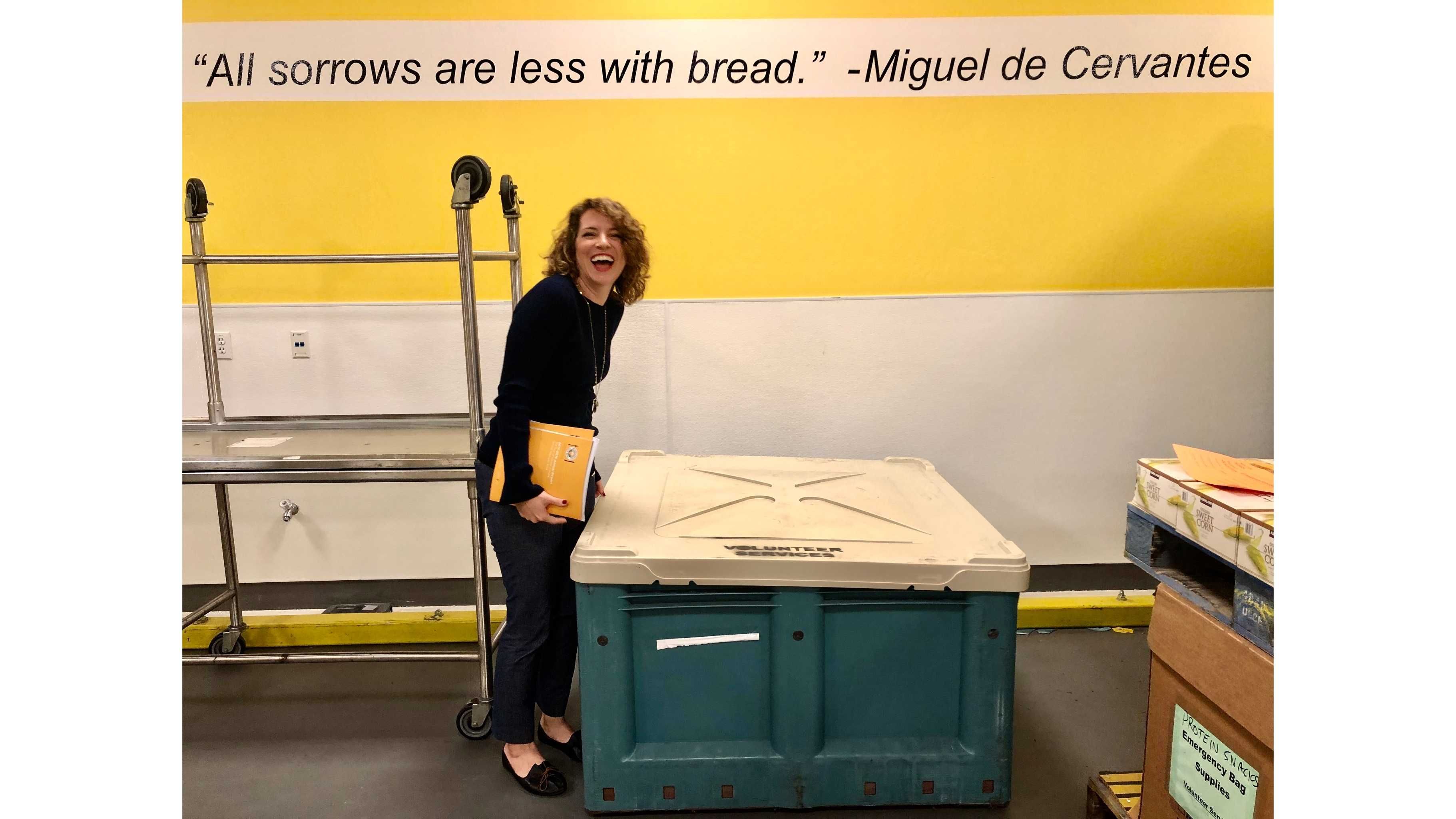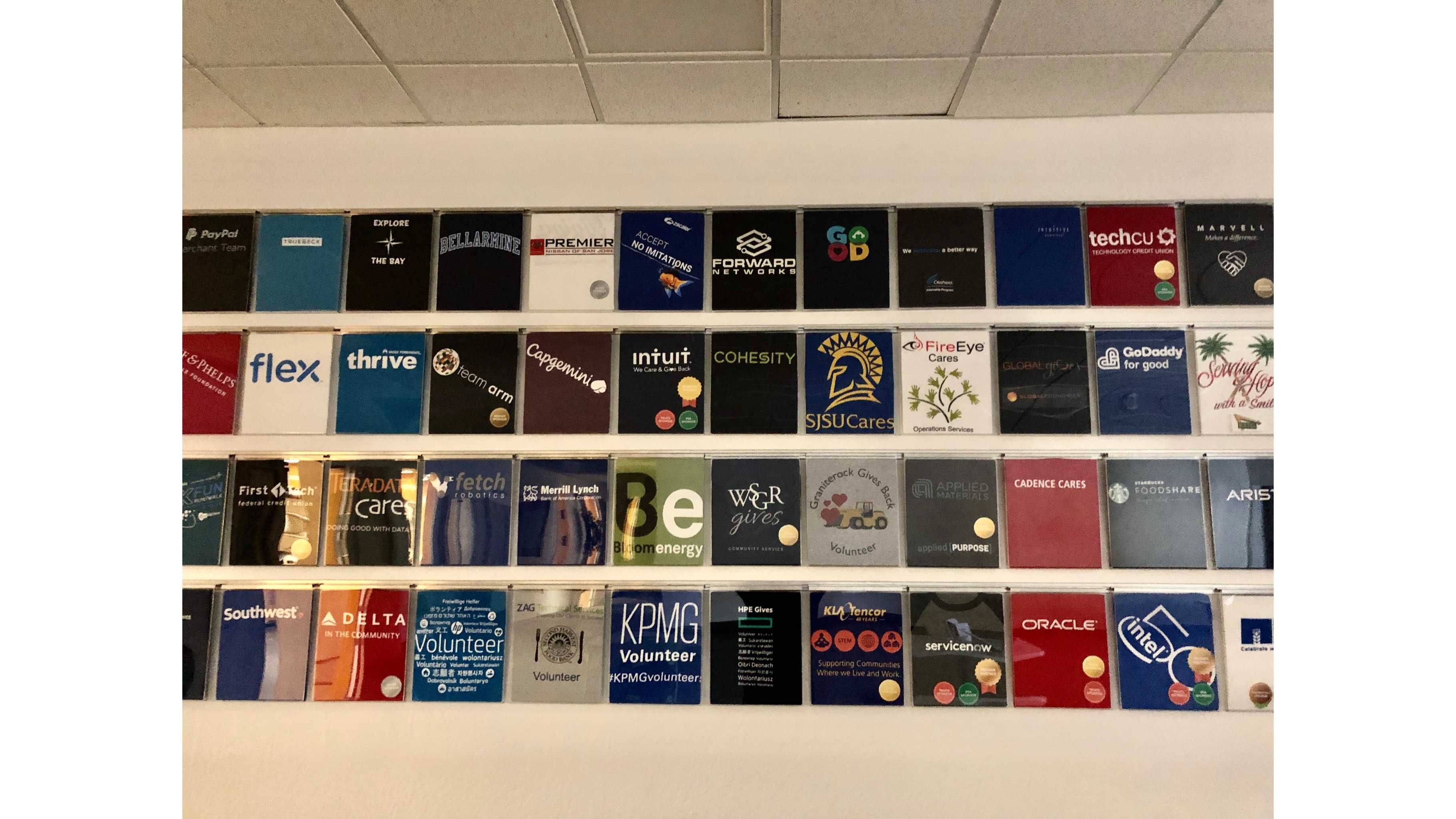We Don’t Always Look Like Our Trauma
DECEMBER 3, 2019

Cat Cvengros – the VP of Development and Marketing at Second Harvest of Silicon Valley in San Jose, CA – explains to Steffan Chirazi that struggle does not discriminate, which is why we must all help without question.
From the moment Cat Cvengros bounds out to meet us in the lobby of the Second Harvest Food Bank in San Jose, there is an enthusiasm about her which is both unique and enormous. She has a dazzling smile, excitable voice, and is instantly both engaging and impossible to dislike. Cat Cvengros is someone whose passion for giant boxes of oranges or huge palettes of potatoes is bordering on incredible. Either she is one of the greatest marketing people an Ivy League college has produced, or there is a deep and feral reason as to why she finds so much joy in what she does. I am intrigued and ask her to dig deep into her childhood for a “moment” or “observed situation” that perhaps left her wanting to do more for those in need.
“We don’t always look like our trauma,” she smiles quietly. “When I was little we went without food. I remember my stepmother took my father’s coin collection to the store and spent it like money, so that a quarter that [to us] was probably worth, you know, 15 dollars, [in the store amounted to just] a quarter…”
Journalists, eh?! There, Steffan, is your observed situation, the “moment” you asked about. Except it proves to be a little more than that, as I will learn in the proceeding minutes. It is another reminder that books most certainly should not be judged by covers, let alone pre-conceptions. Among the many eye-opening things I will learn about her, Cat will tell me (with a smile – there is nearly always a smile regardless of the tale’s gravity) that she listened to The Black Album incessantly at a time when the streets and struggle were major factors in her life, and as we discuss the hunger and temporary homelessness she endured as a child, Cat decides to share the moment when she would no longer allow herself to feel downtrodden.
“I was in middle school, probably eleven or twelve when that movie The Bodyguard came out,” she chuckles. “My friend and I each got five bucks from our parents and we got dropped off at this crappy strip mall in Jackson, Michigan. We go into the lobby and we’re just thrilled! You can smell the popcorn! I was dreaming of the snow caps and the root beer I was gonna get, I was so excited, and then we walked in and saw that [the movie we had intended to see] cost $4.75. And I was like, ‘Oh, that’s not enough for candy.’ That’s all I was there for, really, the candy. We were so despondent. And then we noticed there was a movie that was cheaper, The Bodyguard, and it was a dollar. I’d never heard of it, I was a little kid, I didn’t know anything about it and thank God, the teenager who was working also didn’t care how old we were because it was rated R. So, we got tickets, bought all the candy and soda pop, sat in the back row and we just giggled the whole time! So we got picked up by our respective parents, and later that night my stepmother found the movie ticket in my jacket pocket…this period of my life was marked by physical abuse from the age of seven until fourteen, and I was around eleven… I endured it because I thought I deserved it. I thought this was what happened when you didn’t clean the dishes right, or when you didn’t show up on time after you walk home from school. As a kid you are taught how to receive attention by the attention you receive. I just thought this was normal.”
Cat tails off in a moment of thought, and as uncomfortable as it is to hear, I am doubly aware that it has to be ten times harder to speak about, to remember, and to share with a stranger.
“Anyway, she found that movie ticket stub in my pocket and she lit into me. It was probably the worst beating I’d ever experienced, it left marks on me. I didn’t want to live anymore. At eleven. You’re so little when you’re eleven. I went to school the next day and I wore a long sleeve shirt to hide the marks my stepmom left. I saw my friend that I’d gone to the movie with the day before, and she looked kinda sad. I asked her, “What’s wrong?’ She responded, ‘My mom found the movie ticket stub,’ and my stomach sunk. I was so scared! I said, ‘What did she do to you?’ And she said, ‘I can’t watch TV until Thursday.’ And that’s when I learned that I didn’t deserve it. And so you ask about a turning point? I think it was in that moment that I was like, ‘Oh, maybe I’m not broken.’”
It is more proof that we have no idea what other people have been through – or go through – that so often circumstances accumulate to make a situation so utterly ugly on a daily basis that a person can (without support) quickly end up in a hole too big to climb out of.
“There’s this narrative [surrounding success] a lot of people have that, ‘I did it all myself,’” furthers Cat. “Nobody did it all themselves. People help along the way.” In Cat’s case, it was a history teacher in her High School - Lecanto High - in Florida who proved to be the spirit guide.
“Mr. Bill Hartley!” she beams, “We’re still in touch on Facebook. I still the have quotes that he sent me back then, they’re laminated with packing tape because I was a teenager, I still have them and they’re on my desk. I was just looking at ‘em this morning, in fact. There was zero chance I would be where I am had it not been for Mr. Hartley – who told me it was a case of when I took my ACT and SAT exams, not if – had it not been for my mother – who took me back at 14 after I’d been kicked out and separated from her for years – had it not been for my first boss – who just said, ‘No, you can do better.’
“Back to Mr. Hartley!” she laughs, “The first real ‘trip’ I did as a human, I went with him and the rest of our class to Washington, DC. I worked all summer long to save money for it, I was able to go on this trip and it was the first time I ever had gone to a Starbucks, it was all very ‘fancy’ back then. It was very exciting. I think I trusted him because I could tell he genuinely cared, and he didn’t need to. You know, he didn’t need to care, but he just did, and he wanted us to be our own individual humans, which was really cool.”
With that vital support and encouragement, Cat ended up going to Baldwin Wallace University outside Cleveland, Ohio, and graduating with a Bachelor of Science before joining the Peace Corps and serving in Armenia for two years, a spell of time which was to prove absolutely pivotal in learning how to really help people in need.
“I knew very little about Armenia when I went, and I was placed into a village that did have electricity, and it did have running water too, like a central neighborhood spigot, but not to the homes. When I first got there, I remember the Peace Corps said I would work on projects while there and then leave, hopefully with those projects remaining in operation. That’s the idea. Or I’d continue projects that were started before I got there and evolve and iterate them. And they said I’d be tempted to start projects that were more about what I thought people needed than what they actually needed. It was probably the most important lesson I learned from Peace Corps. They said I needed to wait three to six months before starting to ‘work.’ They encouraged us to talk with our neighbors, have coffee with colleagues. At first, I was like, ‘No, they need running water!’ I missed my showers and I missed the ease with which I could get water at home. But, actually, they didn’t need running water. They needed medical care in villages that didn’t have electricity. They needed awareness that domestic violence wasn’t okay, and they needed somewhere for those women to go. They needed knowledge about how HIV is actually spread, so that [the community didn’t] ostracize somebody who had it and put them outside of society, alone. They needed nutrition knowledge to share with young mothers, they needed young mothers to learn how to take care of their nipples when they were breastfeeding for the first time. Very simple tactical things, but also some of them were very big cultural shifts, like the HIV work. It took me about four months to hear that. And I learned from Armenia that the way to change poverty is to give yourself time to hear what people actually need instead of imposing what you think they need.”
Such experiences have gone on to form the underpinnings of a life spent in service to those in need.
“When I came back I thought, ‘I had this taste of what it was like to serve in a meaningful way in another country and I wanted to do that here in United States,’” she furthers, “so I went to work in Sonoma County on behalf of homeless families and then on behalf of homeless kids and former foster youth, and now here at Second Harvest on behalf of those who need nutritious food.”
Second Harvest is also a distribution hub for other local food pantries and charities, such as Gloria Dei Lutheran Church in San Jose, and as can never be said enough about the primary recipients of food bank aid, they are not who you might think. As the church’s coordinator, Mary De Hart-Madison, tells me, there are an increasing number of people who are falling into the hunger gap who have two or three jobs and are simply being squeezed by a brutal and unfeasibly high Bay Area cost of living.
“At Second Harvest, a growing number of people we serve are these working families,” says Cat, “seniors, children, and families make up a big portion. Those experiencing hunger are working multiple jobs, are seniors trying to age in place with fixed incomes. Many of them have never needed aid before. You can’t always see it. The struggle sometimes shows up as homelessness, but more often it is invisible – it is a family skipping breakfast or eating fast food night after night. Here in Silicon Valley, you’ll see RVs parked on the side of the road where people are living in vehicles versus homes because they can’t afford to have both a safe home and nutritious food to eat.”
Cat and I speak about so many things, and such is her personal experience and enthusiasm, that you still feel there’s so much more to be discussed. We speak about the importance of good, nutritious food to a family, to an individual too. We talk about how it can provide the underpinning for a family to come together, whether that is in preparing a meal, or just eating one, together. We also talk about how important it is to smash the sense of shame which afflicts so many who are in need yet feel stigmatized. In today’s society, the importance of food banks, and the further importance of consistent support from all of us whether in donation of time or money, is vital.

“When you’re packing that corn, some mom is gonna shuck that corn with her kids,” says Cat. “They’re gonna have to deal with the annoying cleanup of it, just like you would in a ‘normal’ dinnertime, and that’s part of a ‘normal’ family situation. One of the grandest things we’re doing is giving someone a sense of normalcy so that they can be the best person they can be in their life. So when you, as a volunteer, are coming in and going through all that produce, know that the food you’re handling is going to be on someone’s counter in a few days. Most of the food we distribute, over 75%, is donated, but we feel it’s important to provide a nutritious spectrum of food to our clients, so we purchase healthy protein like chickens, yogurt, and eggs to supplement all the produce and delicious food we get from our partners like Safeway, Amazon Fresh, and Costco.”
Cat wants you to know just how important those hours you give at a food bank are to the grand scheme of everything which is done by them.
“You get to be this invisible force of connecting that person to their community,” she beams. “It’s sorta like being Spider-Man, you know, you’re in the background doing all this good stuff. You may never get a ‘thank you’ from our clients simply because they don’t see you, but you will definitely get it from us.
“Just as you don’t want to share the times in your life when you’ve been most humiliated and broken, our clients don’t want to share that either. It takes a lot for them to come to our food distributions. The point where a parent finally says, ‘I need help doing this, I need help raising my child, I need help caring for my aunt or my uncle or my parent,’ or whatever, the point where they finally say, ‘I can’t do this myself,’ it’s so very difficult. Going to a distribution where they might know someone and recognize them from their community helps them feel safe. When it is a stranger, it might be extremely intimidating. We ask our volunteers at distributions to commit to consistent schedules because that helps the recipient to feel dignified. Half of what we distribute is dignity. Time spent sorting the food is so important, and to those who are actually going to be on the frontline giving boxes, or handing out meals, it is important those volunteers can be available regularly.”
Cat makes it clear that Second Harvest’s mission is to ensure that anyone who needs a healthy meal can get one. Second Harvest is not a government agency, and the information they collect is self-reported. And it is no surprise to me that Cat Cvengros is not going to be satisfied with the wonderful work being done.
“Right now we’re serving about a quarter million people per month, and we just finished a strategic plan where at the end of three years, we want to serve 40,000 more people per month.”
I’d bet on it happening and then some…

For more information on Second Harvest of Silicon Valley, please visit shfb.org.
For information on national food banks and where you can give, visit feedingamerica.org.


